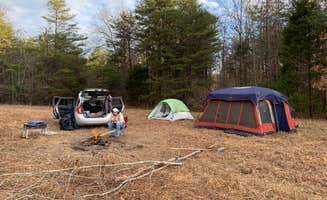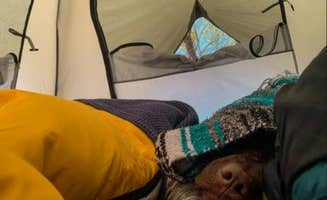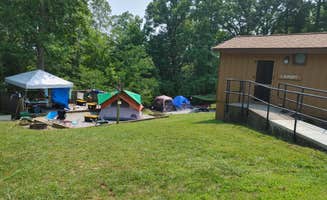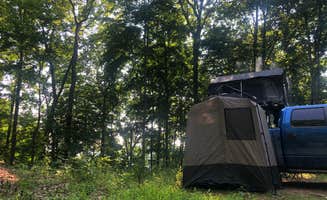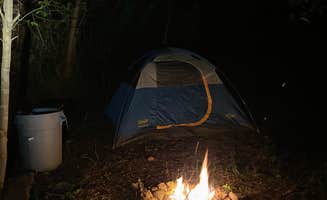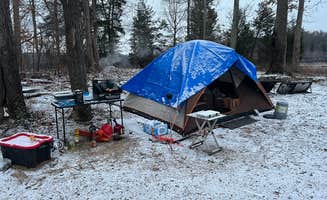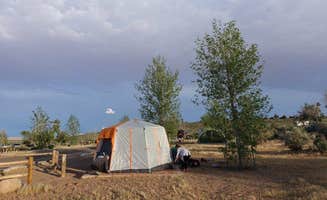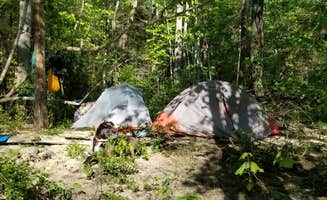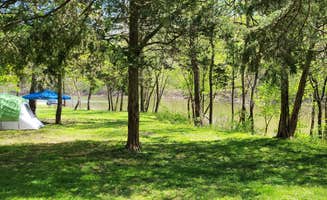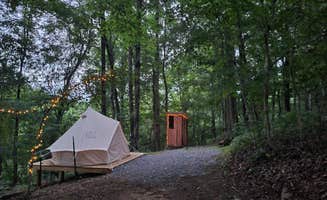Primitive tent campsites near Williamsburg, Kentucky offer opportunities to experience the Daniel Boone National Forest's diverse ecosystems, with elevations ranging from 700 to 1,600 feet. The area sits at the edge of the Cumberland Plateau where Appalachian foothills transition to flatlands. Summer temperatures average 85-90°F with higher humidity near water bodies, while spring and fall provide more moderate camping conditions with temperatures between 50-70°F.
What to do
Boat-in camping access: At Grove Boat-In Campground, reaching campsites requires advance planning. "My first boat was my kayak. I parked at the Grove marina and packed all I could on my kayak and headed to the sites. This was a pretty decent paddle away," notes one camper at Grove Boat-In Campground.
Wildlife observation: Chuck Swan State Forest offers isolated camping with wildlife viewing opportunities. "If you like the night sky and quiet, alone time, this place is perfect. Bring your bug spray, flashlight and TP," advises a visitor to Chuck Swan State Forest.
Shoreline exploration: Multiple shoreline access points allow for water activities. At TVA Public Land-Fork Bend, "There was a tiny beach about 100 yards east of my site for wading -- manageable rock ledges and muddy banks everywhere else. This is a major traffic route, and the lake/river gets very noisy from all the watercraft."
What campers like
Privacy between sites: Clifty Campground offers varying degrees of seclusion. A camper notes, "I loved site 48 at Cliffy Campground. It was the most secluded spot we could find. Definitely book ahead of time if you can," highlighting the popularity of these sites at Clifty Campground.
Primitive camping isolation: Fork Bend provides waterfront primitive camping without facilities. "If you want to get away from people, this place is for you. Fork Bend is a heavily wooded forest surrounded by Norris Lake, which is known for being the best lake around the area," explains a visitor at TVA Public Land-Fork Bend.
Trail proximity: Many tent sites connect directly to hiking paths. Rabbit Road Campground offers walk-in sites with trail access. "The state park offers 5 trails, pavilions, as well as playgrounds and a lake... The camping path and sites were well marked, and sites started at #10, next to the parking lot, and family bathhouse," notes a reviewer from Rabbit Road Campground.
What you should know
Weather impacts access: Roads to primitive sites may require high-clearance vehicles after rain. At North Cumberland WMA, "The road was pretty rough in some places so I would recommend having 4wd just to be safe," cautions a camper at North Cumberland WMA-Royal Blue Unit.
Reservation systems vary: Some campgrounds allow advance booking while others operate first-come, first-served. A Tranquility Creek visitor emphasizes the importance of respecting these areas: "Quiet, clean place to rest. Take nothing but pictures, leave nothing but footprints."
Limited facilities: Most boat-in and primitive sites have minimal amenities. At Grove Boat-In Campground, "There are vault toilets but no showers," making advance preparation essential for longer stays.
Tips for camping with families
Beach areas for children: Several lakeside campgrounds feature shallow water access. At Chuck Swan State Forest, "There is a nice rocky/sandy beach to play in and it stays shallow for a ways out so it would probably be nice for the kids."
Playground accessibility: Some campgrounds offer additional recreational facilities. "The state park offers 5 trails, pavilions, as well as playgrounds and a lake," making White Oak Boat-In Campground a good option for families who can manage boat transportation.
Bugs and wildlife precautions: Prepare for insects, especially near water. "Since it's extremely hot, and there were several areas along the trail with ponds, the biting flies and mosquitoes were active!" warns a camper at Rabbit Road Campground.
Tips from RVers
Limited RV options: Most remote sites accommodate tents only with few RV-suitable locations. At Tranquility Creek, access types include "drive-in" and "walk-in," but accommodation is primarily for tents and glamping rather than larger vehicles.
Road conditions: Forest service roads may present challenges. One camper reports, "All other roads are not as well managed, and some are just double track dirt roads that you'll need 4WD and possibly a winch if it's muddy or rainy," making advance scouting advisable.
Parking considerations: Some areas have separate parking areas requiring walk-in access to actual campsites. "The sites are inconsistent between their sizes on the Clifty campground. We had two small tents and one car. If we had any more gear or people it would have been uncomfortable."


